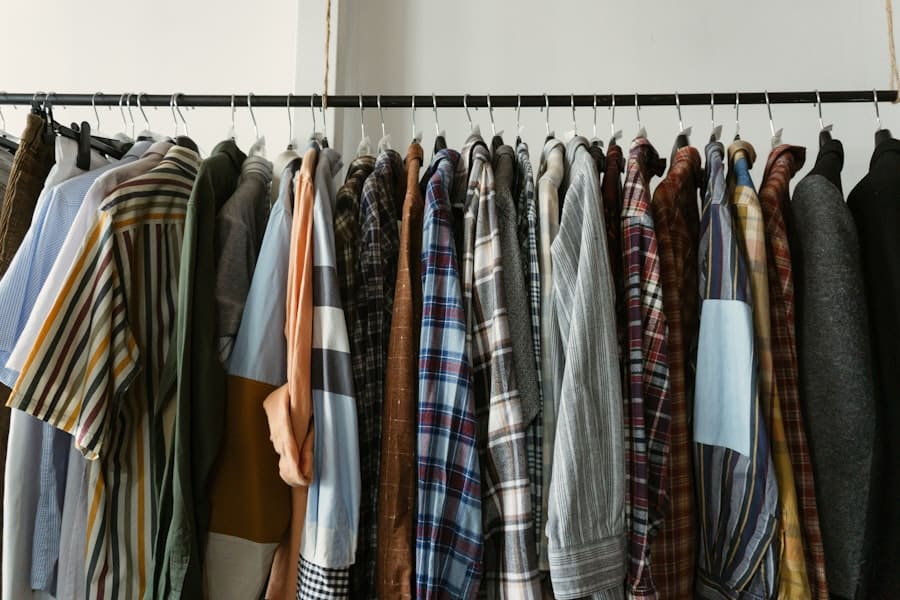The evolution of technology has permeated every aspect of our lives, and the fashion industry is no exception. Smart wardrobes represent a significant leap forward in how we interact with our clothing and manage our personal style. These innovative systems integrate advanced technology, such as artificial intelligence, machine learning, and the Internet of Things (IoT), to create a personalized wardrobe experience.
Imagine a closet that not only organizes your clothes but also suggests outfits based on your preferences, the latest fashion trends, and even the weather outside. This concept is no longer confined to the realm of science fiction; it is becoming a reality for many fashion enthusiasts. Smart wardrobes are designed to enhance the user experience by providing tailored recommendations and streamlining the process of getting dressed.
They can analyze your wardrobe inventory, track your clothing usage, and even remind you of items that have not been worn in a while. By leveraging data analytics, these systems can help users make informed decisions about their clothing choices, ultimately leading to a more efficient and enjoyable dressing experience. As we delve deeper into the mechanics of smart wardrobes, we will uncover how they function, their advantages, and the challenges they face in a rapidly evolving technological landscape.
Key Takeaways
- Smart wardrobes are revolutionizing the way we approach fashion and clothing choices.
- Smart wardrobes work by using technology to track and organize clothing items, as well as provide personalized outfit recommendations.
- Weather plays a crucial role in smart wardrobe recommendations, as the system can suggest appropriate clothing based on the current weather conditions.
- The advantages of using smart wardrobes include saving time, reducing decision fatigue, and promoting sustainable fashion choices.
- However, challenges and limitations of smart wardrobes include cost, technological limitations, and potential privacy concerns.
How Smart Wardrobes Work
Inventory Management
Typically, these wardrobes are equipped with sensors and cameras that can identify and catalog each item of clothing. When a user adds a new piece to their wardrobe, they can scan it using a mobile app or a built-in interface, which then stores essential information such as color, size, fabric type, and even care instructions.
Personalized Recommendations
This digital inventory serves as the foundation for the wardrobe’s recommendations and insights. Once the wardrobe is set up, it employs algorithms to analyze various factors that influence outfit selection. For instance, it can take into account the user’s style preferences, past outfit choices, and even social events on their calendar.
Machine Learning and External Data Integration
By utilizing machine learning techniques, smart wardrobes can learn from user interactions over time, refining their suggestions to better align with individual tastes. Additionally, many smart wardrobes are connected to external data sources, such as weather forecasts and fashion trend reports, allowing them to provide real-time recommendations that are both practical and stylish.
The Role of Weather in Smart Wardrobe Recommendations

Weather plays a crucial role in determining what we wear on any given day. Smart wardrobes leverage this factor by integrating weather data into their recommendation algorithms. For example, if the forecast predicts rain, the wardrobe might suggest waterproof jackets or shoes while also considering the user’s style preferences.
This capability not only enhances convenience but also ensures that users are prepared for varying weather conditions without sacrificing their personal style. Moreover, smart wardrobes can provide insights into seasonal trends based on weather patterns. For instance, if a user lives in an area where winters are particularly harsh, the wardrobe might prioritize heavier fabrics and layering options during colder months.
Conversely, during warmer seasons, it could highlight lighter materials and breathable fabrics. This dynamic approach to outfit selection not only helps users stay comfortable but also encourages them to make the most of their existing wardrobe by rediscovering items that may have been overlooked.
Advantages of Using Smart Wardrobes
The benefits of smart wardrobes extend beyond mere convenience; they also promote sustainability and mindful consumption in fashion. By helping users track their clothing usage and suggesting outfits based on what they already own, smart wardrobes can reduce the impulse to purchase new items unnecessarily. This shift towards a more conscious approach to fashion aligns with growing concerns about environmental impact and fast fashion’s detrimental effects on the planet.
Additionally, smart wardrobes can enhance personal style by encouraging experimentation. Users may feel more inclined to try new combinations of clothing that they might not have considered otherwise. The wardrobe’s ability to suggest outfits based on various criteria—such as occasion, mood, or even color coordination—can inspire creativity and help individuals develop a more distinct personal style.
Furthermore, by providing insights into which items are worn most frequently or least often, users can make informed decisions about future purchases or donations.
Challenges and Limitations of Smart Wardrobes
Despite their numerous advantages, smart wardrobes face several challenges that could hinder widespread adoption. One significant barrier is the cost associated with implementing such technology. High-quality smart wardrobes equipped with advanced features can be prohibitively expensive for many consumers.
This financial consideration may limit access to those who could benefit most from these innovations. Another challenge lies in the complexity of user interfaces and the potential for technological glitches. While many consumers are becoming increasingly tech-savvy, there remains a segment of the population that may struggle with integrating smart technology into their daily lives.
If a smart wardrobe’s interface is not intuitive or user-friendly, it could lead to frustration rather than convenience. Additionally, issues such as connectivity problems or software bugs could undermine user trust in these systems.
The Future of Smart Wardrobes

Revolutionizing the Shopping Experience
Future iterations of smart wardrobes may incorporate augmented reality (AR) features that allow users to visualize outfits without physically trying them on. This could revolutionize how individuals shop for clothing and interact with their existing wardrobe.
Sustainability in Fashion
As sustainability becomes an increasingly pressing concern within the fashion industry, smart wardrobes may evolve to include features that promote eco-friendly practices. For instance, they could provide insights into the environmental impact of certain fabrics or suggest sustainable brands based on user preferences.
Shaping Consumer Behavior
By aligning with ethical fashion movements, smart wardrobes could play a pivotal role in shaping consumer behavior towards more responsible choices.
Ethical and Privacy Considerations
With the rise of smart technology comes an array of ethical and privacy considerations that must be addressed. Smart wardrobes collect vast amounts of personal data, including information about users’ clothing choices, preferences, and even biometric data if integrated with wearable technology. This raises questions about data security and how this information is stored and used by companies.
Consumers may be wary of sharing personal data with brands or tech companies due to concerns about potential misuse or breaches of privacy.
Companies must ensure robust security measures are in place to protect user data while also providing clear information about how this data will be utilized.
The Potential Impact of Smart Wardrobes on Fashion Industry
The emergence of smart wardrobes signifies a transformative shift within the fashion industry that extends beyond mere convenience; it represents an opportunity for greater sustainability and personalization in how we approach our clothing choices. As these technologies continue to evolve, they have the potential to reshape consumer behavior by encouraging mindful consumption and fostering creativity in personal style. While challenges remain in terms of cost, usability, and ethical considerations surrounding data privacy, the benefits offered by smart wardrobes are compelling enough to warrant further exploration and development.
As we look ahead to a future where technology seamlessly integrates with our daily lives, smart wardrobes stand poised to play a pivotal role in redefining our relationship with fashion—making it more efficient, sustainable, and personalized than ever before.
In a related article discussing the future of technology in commerce, Conversational Commerce explores how businesses are utilizing chatbots and messaging apps to enhance customer interactions and streamline the shopping experience. This innovative approach to e-commerce could potentially be integrated into smart wardrobes to provide personalized outfit recommendations based on individual preferences and weather conditions. By incorporating conversational commerce into smart wardrobe technology, users could receive real-time fashion advice and make more informed decisions when selecting their daily outfits.
FAQs
What is a smart wardrobe?
A smart wardrobe is a technologically advanced closet system that uses sensors, cameras, and artificial intelligence to organize and recommend outfits based on various factors such as weather, personal style, and occasion.
How does a smart wardrobe recommend outfits based on weather?
Smart wardrobes are equipped with weather sensors that can detect the current weather conditions. Based on this information, the wardrobe’s artificial intelligence system can suggest appropriate outfits for the day, taking into account factors such as temperature, humidity, and precipitation.
What are the benefits of a smart wardrobe that recommends outfits based on weather?
One of the main benefits of a smart wardrobe that recommends outfits based on weather is the convenience it offers. By taking the current weather conditions into account, the wardrobe can help users save time and effort in choosing appropriate outfits for the day. Additionally, it can also help users dress more comfortably and appropriately for the weather.
Are there any privacy concerns with smart wardrobes?
As with any technology that collects and processes personal data, there are potential privacy concerns with smart wardrobes. Users should be aware of the data that is being collected and how it is being used. It’s important to choose a smart wardrobe from a reputable manufacturer that prioritizes user privacy and data security.
What are some other features of smart wardrobes?
In addition to recommending outfits based on weather, smart wardrobes may also offer features such as virtual fitting rooms, inventory management, and personalized style recommendations. Some smart wardrobes can also integrate with other smart home devices and platforms for a seamless and connected experience.

